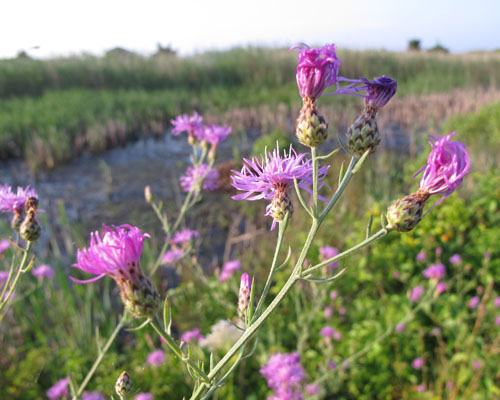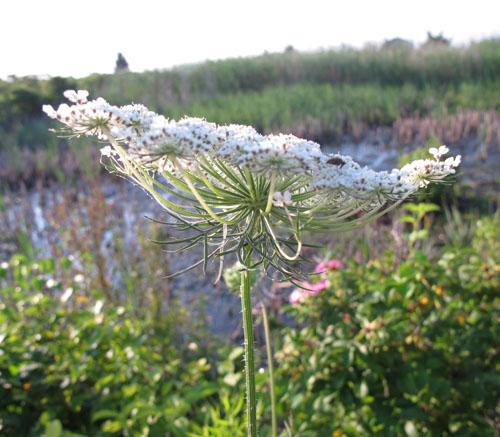Sunday was another beautiful morning on the bike path to Woods Hole. All around me there were people setting up traffic cones and water stations for the triathlon. I managed to take a few pictures before the race started at 7:30. I’ve just been informed by a reader that the invasive knapweed below is a neuro-toxin and should not be handled!
Young Queen Anne’s Lace looks like an umbrella forced inside out by the wind.
And then later, the flower forms into a properly domed umbrella.





Very pretty flowers and photos–particularly with water in the background!
You have captured the grace of a summer’s afternoon in these photographs. I felt as if I was on the afternoon’s ride through the country. THANK you for sharing this moment. Imagine and live in Peace, mary Helen Fernandez Stewart
Dear Salley,
Thank you for sharing the colorful wildflower pictures from your morning bike ride. It’s fortunate for us to ‘ride along’ with you! Just a note, your first picture is of a noxious weed, known as Knapweed. It is highly invasive and a known neuro-toxin. Knapweed is unsafe to touch by unprotected hands and skin, Forest Service workers here in Idaho who hand removed it from hillsides along our famous white-water rivers have had to have their fingers and hands removed due to the life threatening consequences as a result of contact with this dangerous weed. It first made it’s appearance on the west coast at the turn of the century as a stowaway in ship’s ballast coming from the far eastern seaports of Russia. Railways then continued it’s introduction into the far west.
Thanks for the information, Nikki. I didn’t touch the weed and will be sure not to, now. There are many invasive plants on our coast and I wasn’t aware of this variety.
I really appreciate your blog and I consider your posts generally highly responsible, but have you checked this?
According to UK sites, common knapweed is considered invasive in North America but is a common and important wildflower here (https://www.plantlife.org.uk/uk/discover-wild-plants-nature/plant-fungi-species/knapweed-common). There’s no mention of any health hazard and the RHS sells it (https://www.rhs.org.uk/Plants/3367/i-Centaurea-nigra-i/Details).
Knapweed includes cornflowers and hundreds of species according to Wikipedia which does mention toxins in some species considered invasive in North America. However, it is the roots which seem to produce these to inhibit plant growth around them. Wikipedia does mention some species cause skin irritation and they can be damaging to other flora, fauna (e.g. horses) and agriculture. But there’s nothing to suggest that merely touching one is dangerous. Some species are apparently eaten and they are good nectar producers.
https://www.sciencedirect.com/topics/agricultural-and-biological-sciences/russian-knapweed has various papers on knapweed and toxicity. These seem to implicate two species if eaten in large quantities by horses, sheep etc. I’m not good at flower ID, but are you sure that picture is of Russian knapweed rather than something like common knapweed? (I’m not good, but I’m pretty sure it isn’t yellow starthistle.) Common knapweed (or one of the others) is still invasive in North America but, if it is dangerous, we’ve really been living on the edge all these centuries in Europe.
I can find some mentions of spotted knapweed allegedly causing cancer in an Idaho man who had to have two fingers amputated, but I can’t find a trustworthy source for this and I don’t see anything purporting to establish even correlation, never mind causation. (The man couldn’t think what else caused the tumours in his fingers. He did work for the forestry service. He did write about it. He did get calls from people convinced their leukaemia must be caused by knapweed. This is the strongest case I could find from a source I know nothing about.)
I can’t find any mention on any official site or any warnings about not touching even the two toxic species. Given knapweeds are among the plants we want people to plant in the UK (and probably elsewhere in Europe, at least), your warning strikes me as well-intentioned but potentially damaging scaremongering.
The flowers are beautiful and I love to see the results of your bicyling trips! What fascinating info about the knapweed. So, is there a push to eradicate this plant from the earth? Sounds like a good idea to me!